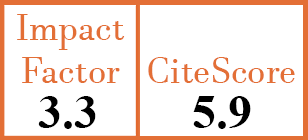Clinical aspects
Remarkable damage along with poor quality of life in Takayasu arteritis: cross-sectional results of a long-term followed-up multicentre cohort
A. Omma1, B. Erer2, O. Karadag3, N. Yilmaz4, F. Alibaz-Oner5, F. Yildiz6, M. Kalfa7, G. Kimyon8, S. Kiraz9, H. Direskeneli10, E. Erken11, K. Aksu12, A.M. Onat13, A. Gül14, L. Ocal15, M. Inanc16, S. Kamali17
- Division of Rheumatology, Department of Internal Medicine, Istanbul Medical Faculty, Istanbul University, Turkey.
- Division of Rheumatology, Department of Internal Medicine, Istanbul Medical Faculty, Istanbul University, Turkey. burakerer@yahoo.com
- Division of Rheumatology, Department of Internal Medicine, Hacettepe University, Medical Faculty, Ankara, Turkey.
- Division of Rheumatology, Department of Internal Medicine, Marmara University, School of Medicine, Istanbul, Turkey.
- Division of Rheumatology, Department of Internal Medicine, Marmara University, School of Medicine, Istanbul, Turkey.
- Division of Rheumatology, Department of Internal Medicine, Cukurova University, Medical Faculty, Adana, Turkey.
- Division of Rheumatology, Department of Internal Medicine, Ege University, School of Medicine, Izmir, Turkey.
- Division of Rheumatology, Dept. of Internal Medicine, Gaziantep University, Gaziantep Medical Faculty, Gaziantep, Turkey.
- Division of Rheumatology, Department of Internal Medicine, Hacettepe University, Medical Faculty, Ankara, Turkey.
- Division of Rheumatology, Department of Internal Medicine, Marmara University, School of Medicine, Istanbul, Turkey.
- Division of Rheumatology, Department of Internal Medicine, Cukurova University, Medical Faculty, Adana, Turkey.
- Division of Rheumatology, Department of Internal Medicine, Ege University, School of Medicine, Izmir, Turkey.
- Division of Rheumatology, Dept. of Internal Medicine, Gaziantep University, Gaziantep Medical Faculty, Gaziantep, Turkey.
- Division of Rheumatology, Department of Internal Medicine, Istanbul Medical Faculty, Istanbul University, Turkey.
- Division of Rheumatology, Department of Internal Medicine, Istanbul Medical Faculty, Istanbul University, Turkey.
- Division of Rheumatology, Department of Internal Medicine, Istanbul Medical Faculty, Istanbul University, Turkey.
- Division of Rheumatology, Department of Internal Medicine, Istanbul Medical Faculty, Istanbul University, Turkey.
CER9578
2017 Vol.35, N°1 ,Suppl.103
PI 0077, PF 0082
Clinical aspects
Free to view
(click on article PDF icon to read the article)
PMID: 27908308 [PubMed]
Received: 13/05/2016
Accepted : 29/07/2016
In Press: 10/11/2016
Published: 19/04/2017
Abstract
OBJECTIVES:
We aimed to assess the outcome of a large Takayasu arteritis (TAK) cohort using the vasculitis damage index (VDI) and quality of life (QoL) scale, tools which have been validated for vasculitis.
METHODS:
Disease activity, damage and QoL were cross-sectionally evaluated in 165 TAK patients from 6 centres. SF-36 were applied to 51 age-matched healthy controls (HC). Persistent activity for ≥6 months was considered as treatment resistance (r-TAK). The correlation between VDI, clinical characteristics and mental (MCS)/physical (PCS) component scores of SF-36 were analysed. SF-36 and VDI scores were compared between TAK subgroups and HC.
RESULTS:
The median age, follow-up time and disease duration were 40 (17-68), 60 (6-384), and 72 (6-396) months, respectively. 35% of them were r-TAK. VDI scores (VDIs) in TAK 4 (1-12) were mainly due to the disease itself [4 (1–10)]. VDIs in r-TAK were significantly higher than nr-TAK [5 (2-12) vs. 3 (2-10), p<0.001)]. In the TAK patients, MCS and PCS were found as 43±10 and 38±11, respectively. A high proportion of poor MCS (70%) and PCS (80%) were demonstrated in TAK. A significantly negative but weak correlation was observed between VDI and MCS (p=0.003, r=-0.23), PCS (p<0.001, r=-0.34). Higher VDIs were detected in patients with PCS <50 [5 (1-12) vs. 2 (1-6) p<0.001)]. SF-36 score was significantly lower in TAK than HC.
CONCLUSIONS:
Disease-related damage mainly caused by peripheral vascular involvement was more predominant than treatment-related damage without reaching the level of severe damage scores, but contributing to poor QoL, in the TAK cohort.


